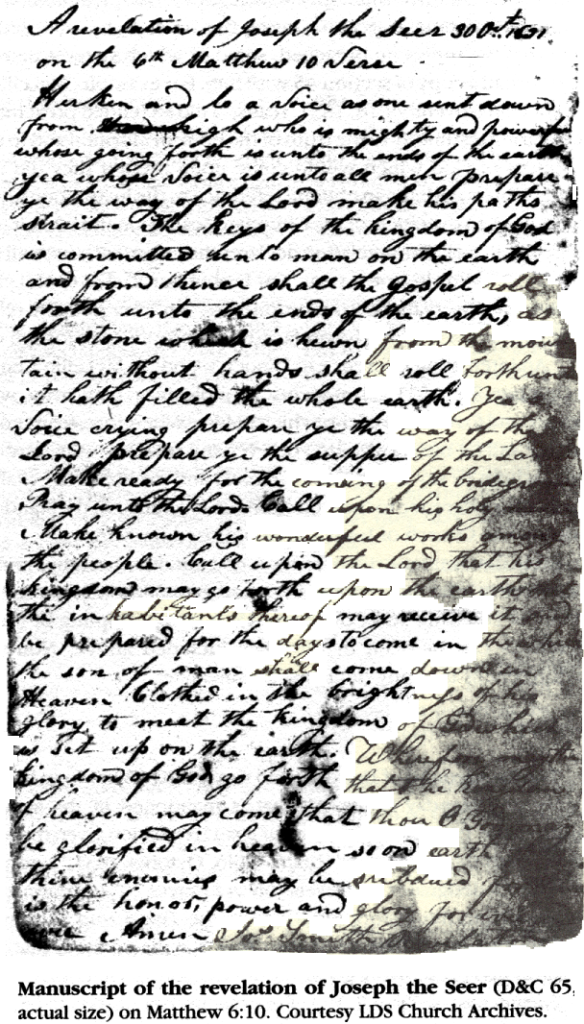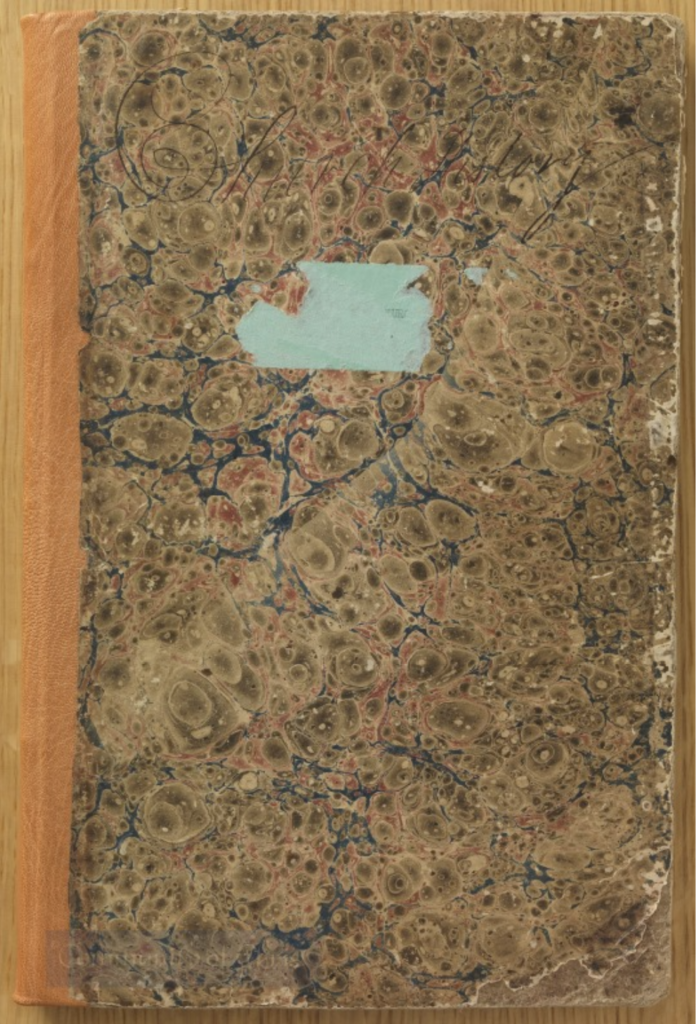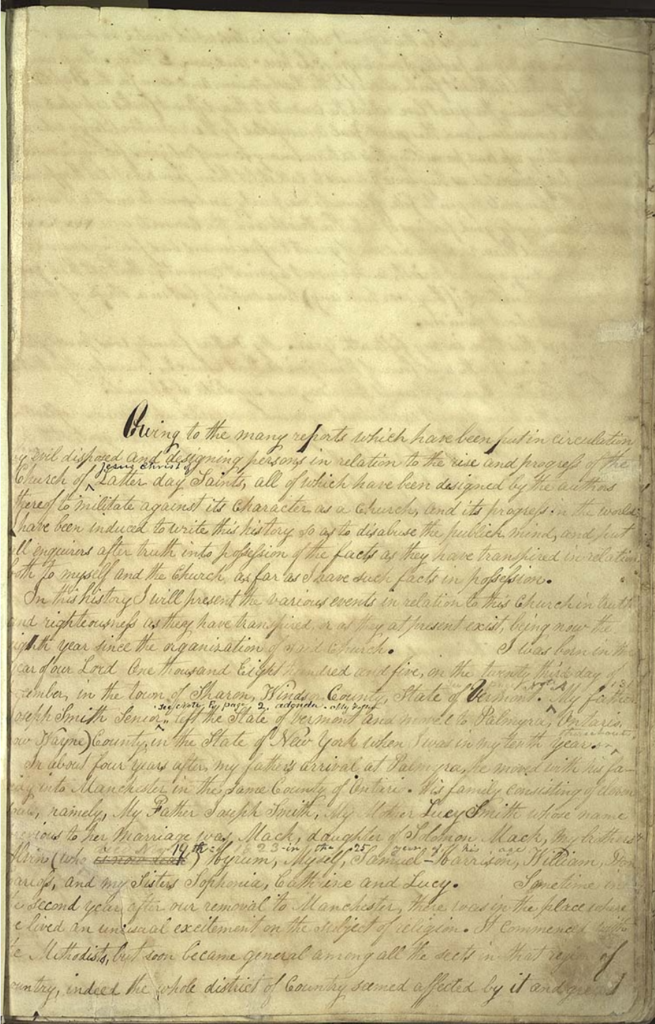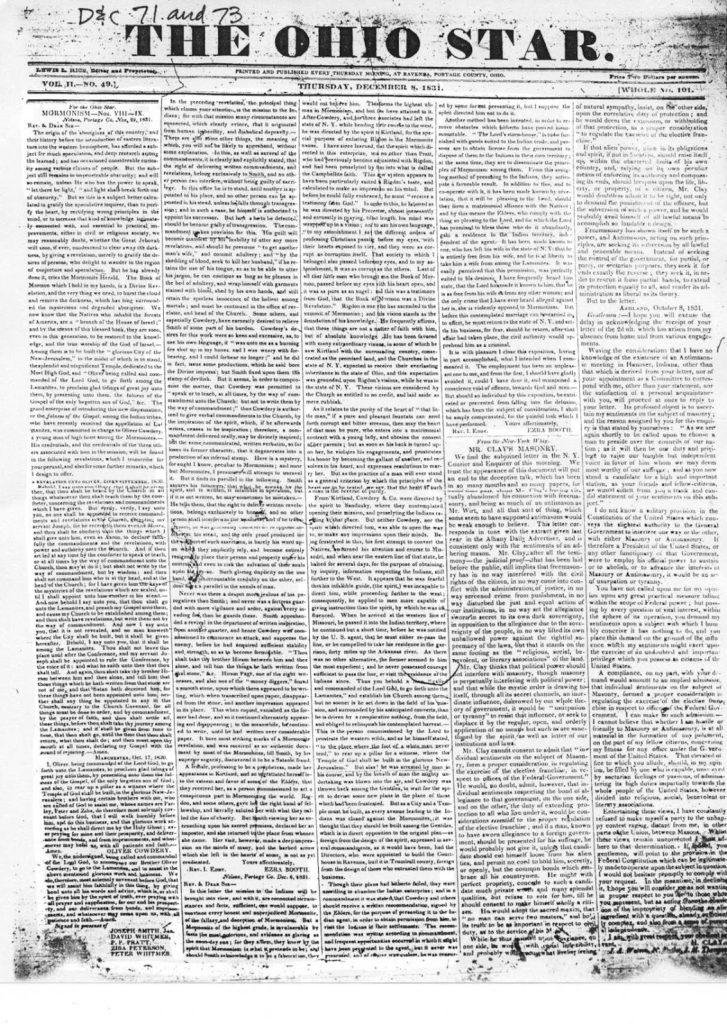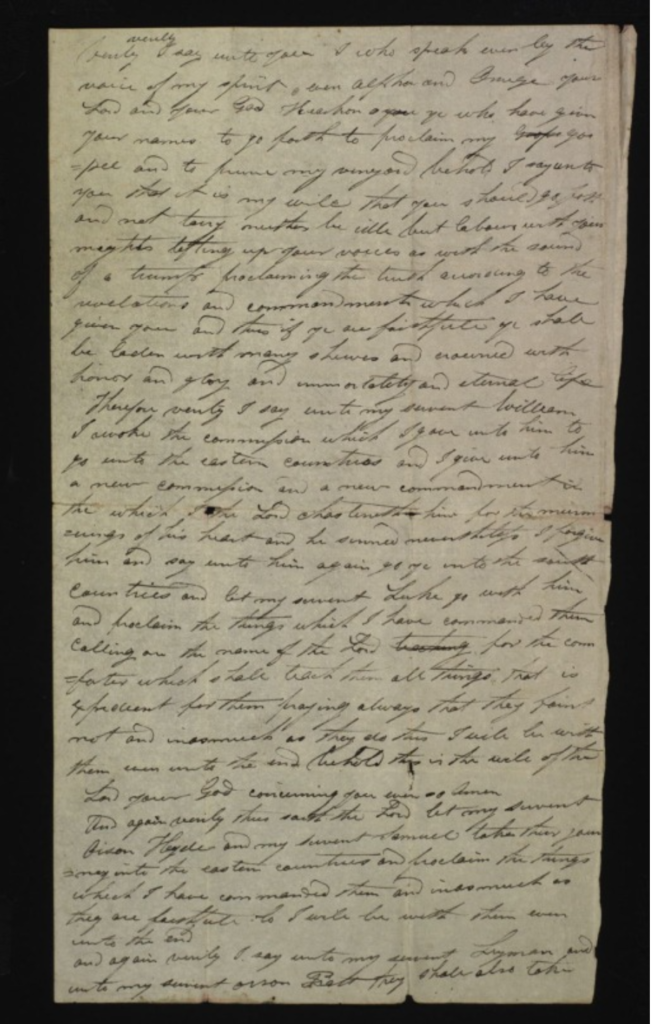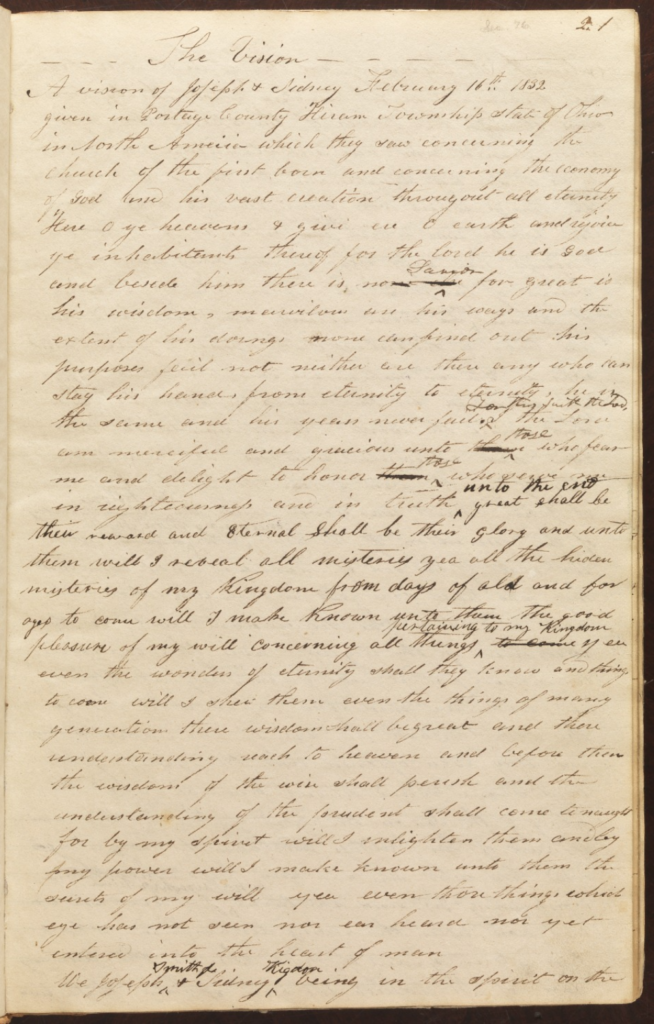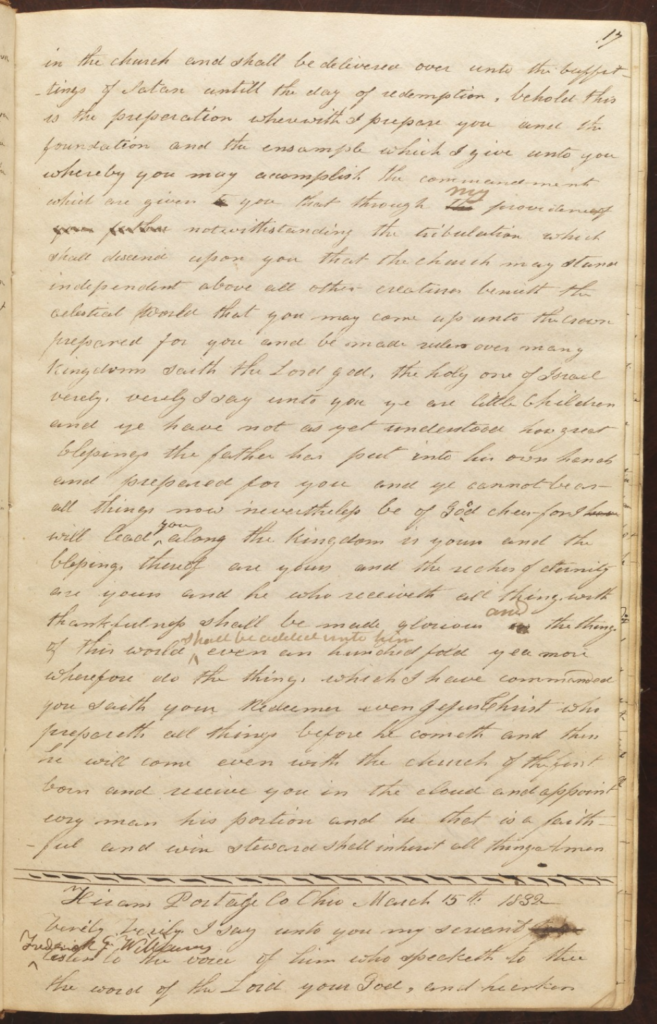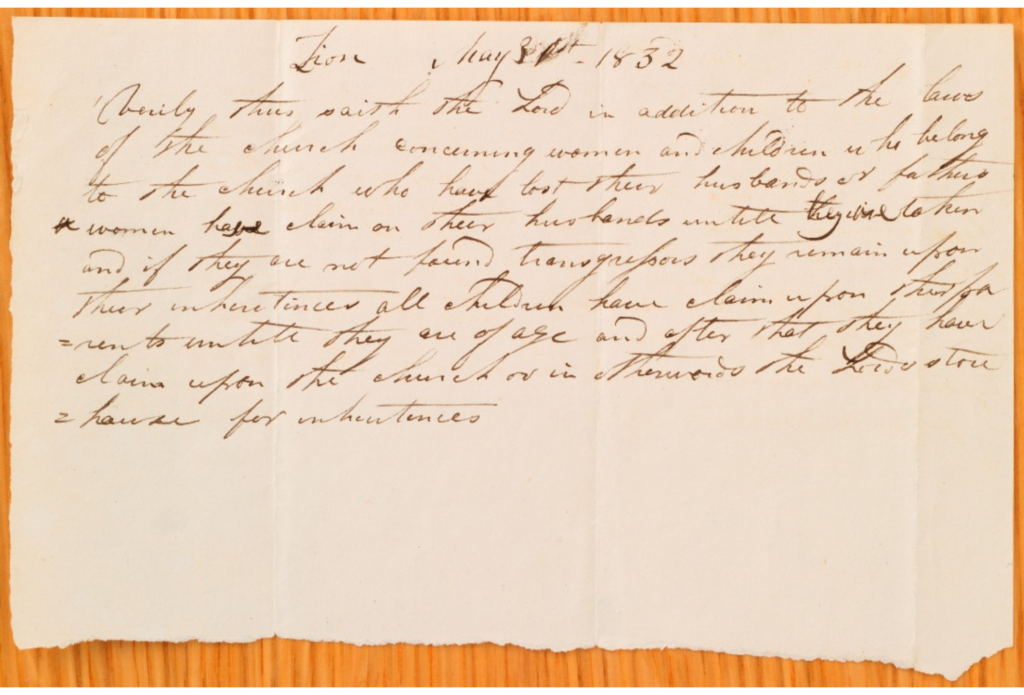Section 51
In the spring of 1831, Bishop Edward Partridge had a problem. It was his job to organize and settle the saints who were gathering from New York to Ohio. Leman Copley was a member of the United Society of Believers in Christ’s Second Appearing when he converted to the restored gospel in Ohio. He offered to let the Colesville saints settle on some of his 759 acres in Thompson.[1] Bishop Partridge asked Joseph how to organize the immigrant saints. Joseph asked the Lord, who gave Section 51, “A revelation given to the Bishop at Thompson Ohio May 20th 1831 concerning the property of the Church.”[2]
This revelation begins to implement the law of consecration. Initially it instructed Bishop Partridge to obtain a deed from Leman Copley for his land “if he harden not his heart.” Copley returned to his former faith, however, and rescinded his offer for the gathering saints to settle on his land. He did not give consent to Bishop Partridge obtaining the title to it.[3] When Section 51 was first published in 1835, its instructions about Bishop Partridge obtaining a deed to Copley’s land were long since irrelevant, and were omitted from the published version.[4]
The saints who had gathered on Copley’s property were told by the Lord to gather to Missouri instead (section 54). Bishop Partridge implement section 51 in Missouri. He purchased hundreds of acres and established a storehouse to supply the needs of the saints. He was sued by a fellow named Bates who had donated fifty dollars to purchase land, then decided he wanted it back.[5] The suit was granted, apparently on the grounds that the bishop did exactly what Section 51 originally said. He purchased the land in his own name and then leased parts of it to individual stewards while he remained, on behalf of the Lord, the legal owner.
Bishop Partridge must have felt like the law of the land prohibited him from carrying out Section 51. Joseph wrote to Bishop Partridge in Missouri in May 1833 to counsel him what to do, explaining much of Section 51 in the process. Bates had expected something tangible in return for his fifty dollars.[6] Joseph assured the bishop that he remained bound by the law of the Lord to receive consecrated property to purchase inheritances for the poor. Joseph emphasized that such offerings were legal and in no way coerced. “Any man has a right . . . agreeable to the laws of our country, to donate, give or consecrate all the he feels disposed to give.” Joseph counseled the bishop to ensure that all offerings were legal by making sure that donors understood they were giving money freely for the poor, not in exchange for anything temporal. “This way no man can take advantage of you in law,” Joseph wrote.
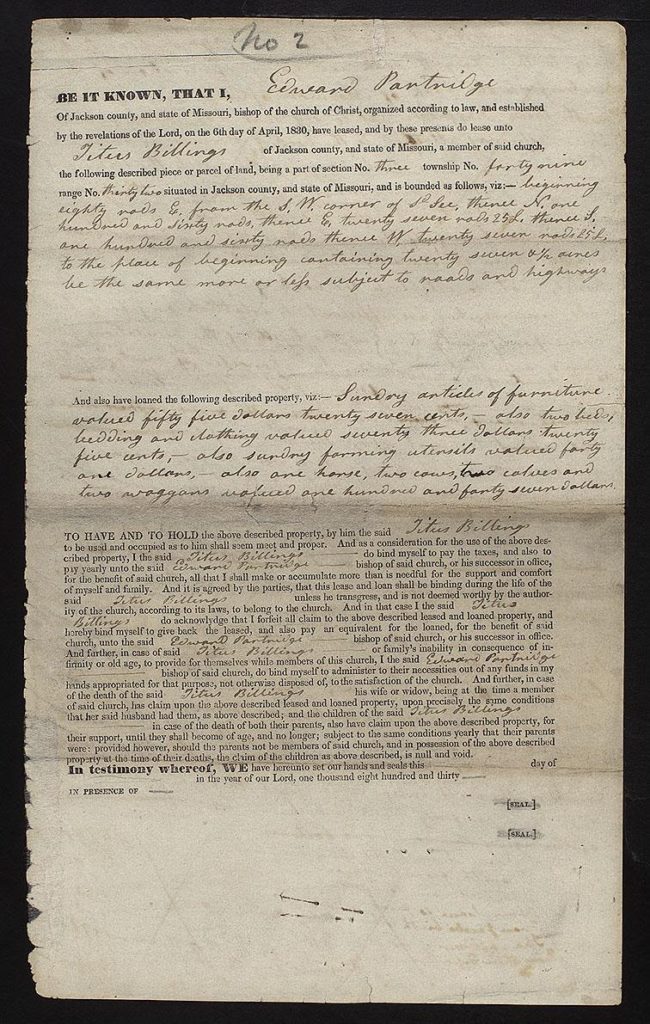 He also counseled the bishop to apply Section 51 by deeding pieces of land to saints as their “individual property.” Joseph called this “private stewardship,” not ownership. Bishop Partridge issued several such deeds based on Section 51. (See Titus Billings example.) When Section 51 was first published in 1835, much of verse 5 was added to keep folks like Bates from suing the Lord’s bishop. Joseph wrote to Bishop Partridge that the revelation in D&C 51:5 was given so “that rich men cannot have power to disinherit the poor by obtaining again that which they have consecrated.”[7]
He also counseled the bishop to apply Section 51 by deeding pieces of land to saints as their “individual property.” Joseph called this “private stewardship,” not ownership. Bishop Partridge issued several such deeds based on Section 51. (See Titus Billings example.) When Section 51 was first published in 1835, much of verse 5 was added to keep folks like Bates from suing the Lord’s bishop. Joseph wrote to Bishop Partridge that the revelation in D&C 51:5 was given so “that rich men cannot have power to disinherit the poor by obtaining again that which they have consecrated.”[7]
Section 52
Acting on Section 44’s commandment to convene a conference, Joseph promised the priesthood leaders a blessing if they would come humbly and faithfully. “Therefore,” John Whitmer wrote, “the elders assembled from the East, and the West, from the North and the South.”[1] Joseph presided over the series of priesthood meetings from June 3-5, 1831. He and others prophesied at the conference, rebuked the devil, and ordained the first high priests in the church. The next day he received Section 52, which he described as “Directions to the Elders of the Church of Christ.”[2]
Section 52 gives the saints knowledge and therefore power to discern devilish counterfeits from the Lord’s power. Satan tried mightily to deceive the saints from the time missionaries first arrived in Ohio through the priesthood meetings just prior to Section 52. He mimicked spiritual gifts and convinced many people they were under the influence of the Holy Ghost. Joseph taught that “some, by a long face and sanctimonious prayers, and very pious sermons, had power to lead the minds of the ignorant and unwary.”[3] The fact that someone speaks well or is overwhelmed with emotion is not evidence that their actions are acceptable to God. Section 52 adds important criteria for discerning. Do those overcome with emotion regain their composure and teach wise, restored truth? Do those who pray, whose attitude seems Christian, obey the ordinances Jesus has established his church and kingdom? Do they follow the revealed order of the Savior’s church? Do excellent speakers obey Christ’s ordinances? Christ does not accept the sanctimonious prayers or pious sermons of those who are unwilling to obey his ordinances, and neither should the saints. The knowledge in Section 52 empowers the saints to separate satanic imitations from the Lord’s power.
Section 52 is exciting. This is the first revelation to identify Missouri as the location of Zion, the saints’ inheritance. It calls twenty-eight men to travel to Missouri for a conference at which the Lord will reveal more specifically the location for New Jerusalem. The saints received Section 52 with great anticipation and many went to great lengths to obey its commands.
Joseph and others the Lord called to travel with him left Kirtland, Ohio in mid-June and arrived in Independence, Missouri about a month later. Most of the others who were called followed, taking different routes and making converts along the way, as Section 52 commanded. The Lord fulfilled his Section 52 promise to reveal more about Zion (See Section 57).
Section 52 draws the battle lines for a culture war. Missouri, it says, is the place the Lord chose for the saints’ inheritance. In 1831, however, Missouri was inhabited by people the Lord called “enemies” (verse 42). The Lord’s straightforwardness makes some readers squeamish. It doesn’t sound to them like their idea of Jesus Christ. If so, just keep reading the scriptures until the sentimental image of Jesus is replaced by the actual Christ whose voice dominates the Doctrine and Covenants. He sees things as they are and will be and speaks the truth. He knows who are his friends and who are his enemies. He demonstrates this knowledge in Section 52 and elsewhere in the Doctrine and Covenants. We come to know him by hearing his voice.
Section 53
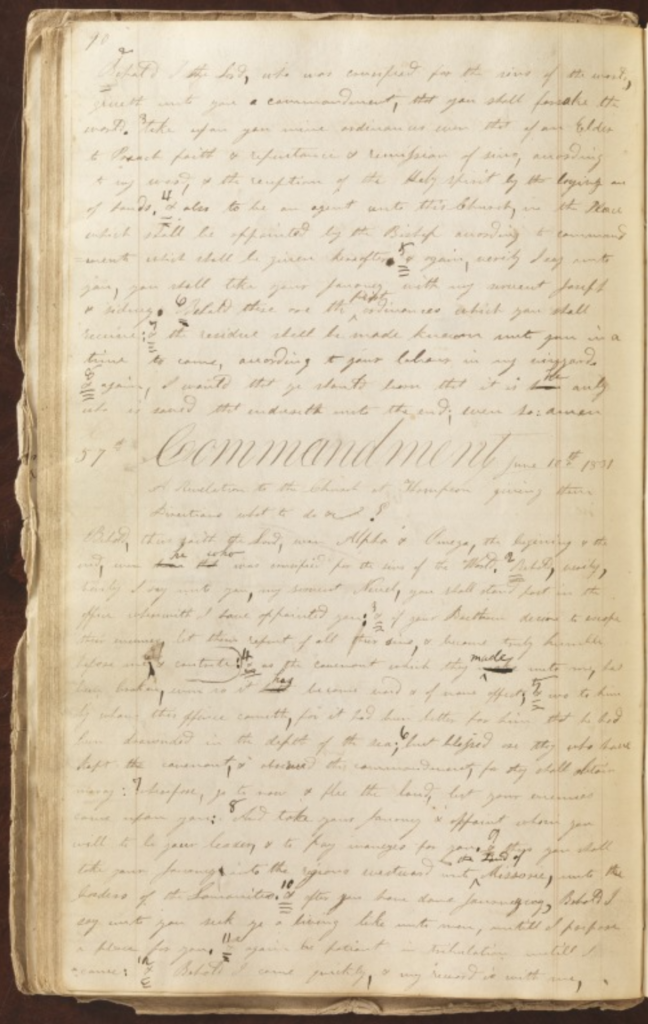
Sidney was an entrepreneur a business partner of Newel Whitney in northern Ohio when the first missionaries to that area converted him in 1830. In the late spring of 1831, Sidney may have felt left out. He was not named in section 52 among the many missionaries called by the Lord to journey to Missouri that summer, and Joseph had prophesied that “the elders would soon have large congregations to speak to and they must soon take their departure into the regions west.” So Sidney asked Joseph what the Lord had in mind for him to do.[1]
The Lord had important work for Sidney and his family to do. He and his wife Elizabeth traveled to Missouri with Joseph Smith to obey section 53. There, at the Lord’s command (section 57), Sidney established a store to provide for the saints. He helped bishop Partridge purchase land for Zion. When the saints were driven from Jackson County in 1833, Sidney was among the church leaders who tried to pacify the mob and then obtain justice. The dreaded disease cholera slew Sidney in the summer of 1834. Until the end he was anxiously engaged in the cause of Zion.
Section 54
Newel Knight led the New York saints to Thompson, Ohio, where they settled on Leman Copley’s land and “commenced work in all good faith thinking to obtain a living by the sweat of the brow.”[1] Then Section 51 instructed Bishop Partridge to obtain a deed from Leman for the land “if he harden not his heart.”[2] But after obeying section 49’s command to preach the gospel to members of the United Society of Believers in Christ’s Second Appearing, Leman forsook his faith in the restored gospel and returned to that Society.[3] Then he ordered the saints off his land.
Joseph Knight said they “had to leave his farm and pay sixty dollars damage for putting up his houses and planting his ground.”[4] Where should they go and what should they do to provide for themselves? Joseph’s history says that the saints in Thompson, “not knowing what to do, sent in their elders for me to inquire of the Lord for them.” He did, and the Lord answered with Section 54.[5]
The eternal Lord Jesus Christ who was crucified for the sins of mankind speaks to Newel Knight, presiding Elder of the saints in Thompson. “You must stand fast in the office whereunto I have appointed you,” the Savior says. The Lord makes repentance and humility the conditions on which the saints in Thompson will escape their enemies. Because Leman Copley broke his covenant to consecrate land, the covenant is null and void. The Lord blesses the saints who have kept the covenant. He commands them to flee from their enemies by traveling to Missouri as a group, appointing a treasurer to pay fares and tolls along the way.
Western Missouri which borders on the territory recently set apart by the U.S. government for Native Americans to settle. The Lord commands the saints to find ways to make a living after they arrive until Zion can be established and land provided for them to inhabit. He commands them to patiently endure hardships until the Lord’s coming. He will reward those who seek him. The souls of these early converts will rest with the Lord.
As a result of Section 54, the saints from Colesville, New York continued their group trek all the way to Missouri. Led ably by Newel Knight, they became the nucleus of the church in Jackson County and gave their lives to building Zion.
Section 55

William Phelps edited the Ontario Phoenix newspaper in Canandaigua, New York. He was all mixed up inside. He aspired to prestigious offices, could be strikingly arrogant and condescending, and within weeks of the publication of the Book of Mormon he gained a deep and abiding testimony of it. After several months he visited Joseph Smith and determined to “quit the folly of my way, and the fancy and fame of this world, and seek the Lord and his righteousness.”[1] Shortly after most of the saints in New York left to gather to Ohio, William gave up his newspaper and set out with his family to gather with the saints. He arrived in Kirtland in June 1831 and told Joseph he had come “to do the will of the Lord.” Joseph asked the Lord what that was and the Lord answered with section 55.[2]
In section 55, the Lord continues to recruit talent into his Church to lay the foundation of Zion. William was called to assist Oliver Cowdery as a printer, editor, and writer for the church, including producing books for the education of children. This calling requires William to go to Missouri with Joseph and Sidney to settle and work there. The Lord commands Joseph Coe to go with them also, and promises to reveal more later according to his will.
William Phelps obeyed section 55. He submitted to baptism and confirmation. He traveled with Joseph to Missouri and became the Lord’s printer there. He published the church’s first newspaper, hymnal, and Joseph’s revelations. Joseph Coe also responded to the Lord and traveled to Missouri to obey section 55.
Section 56
Think of section 56 as an emergency mission transfer. In section 52, Ezra Thayer had been called as Thomas Marsh’s companion on a mission to Missouri. Thomas got ready to go as called. Ezra balked. The same revelation called Newel Knight and Selah Griffin as companions to the same mission. When the saints from New York were not able to stay on the Copley farm and the Lord directed them to move on to Missouri in section 54, he called Newel Knight to remain as their leader. So Thomas Marsh and Selah Griffin needed new companions. The Lord assigns them to each other in section 56.
Some readers are disturbed by this section and others like it when the Lord changes course. How can that be, some wonder, if the Lord is always the same and knows everything? It seems inconsistent. Close reading of section 56 and revelations related to it shows it to be consistent with the Lord’s way, however. He locates agency in individuals and then responds, as needed, to the way those people choose to act. Leman Copley could have kept his covenant to let the New York saints settle on his land, freeing Newel Knight to go on the Missouri mission. Ezra Thayer could have accepted the call to go with Thomas Marsh on the Missouri mission.
If the Lord had simply used his foreknowledge to avoid calling them to the work, they could not be free to choose whether to obey his will or not. He would have predetermined their choices instead of empowering them to choose for themselves. The Lord knew well when he called Ezra that he would have to choose to “humble himself” and that he would join Thomas only “if he be obedient to my commandments.”[1] Moreover, the Lord revoked the commandment for Newel to be Selah’s companion “in consequences of the stiffneckedness of my people . . . and their rebellions.”[2]
Thomas Marsh and Selah Griffin obeyed Section 56. As Thomas put it, they “journeyed to Missouri preaching by the way.”[3] From the beginning of the restoration, the Lord has extended calls to people who will not accept them or who fail to fulfill them. The Lord revokes the refused callings and rearranges assignments and the work gets done without the help of the unwilling. That’s a vastly superior plan to never calling anyone who might fall short or refuse to serve. Revelations like section 56 honor our choices and prophesy their sometimes painful consequences.
Section 57
Section 57 is the first revelation Joseph received in Missouri. After receiving the commandment to travel there from Ohio in section 52, it took Joseph two weeks to prepare and a month to make the long trip. Mindful of prophecies of Isaiah, Joseph asked the Lord for details concerning their fulfillment: “when will the wilderness blossom as the rose; when will Zion be built up in her glory, and where will thy Temple stand unto which all nations shall come in the last days.”[1] Joseph described how the Lord answered with section 57.[2]
The Lord identified Independence, Missouri as the center of the place he appointed and consecrated for the gathering of the saints. It is the promised land, the site for New Jerusalem, the city of Zion. As if Joseph was a disoriented pedestrian, the Lord directs him to the spot where the temple should be built just a few blocks west of the courthouse. The Lord desires the saints to purchase that land and every tract they can in what is now Kansas City (all the way to the territory created in 1831 for Native Americans) and Independence. This land is ultimately to be inherited by faithful saints.
The Lord commands Bishop Partridge to carry out his duties outlined in sections 41, 42, and 51. The Lord appoints Sidney Gilbert as the Bishop’s real estate agent, with directions to establish a store to supply the saints’ needs and to use the revenue to buy the land. Gilbert is also to obtain a license from the Indian agents to permit him get involved in supplying the Native Americans. The point of that is to get access to give the restored gospel to Native Americans and employment and resources for the saints.
The Lord appoints William Phelps as the church’s printer and commands him to set up shop in Independence and use his skills to obtain as much money as he righteously can in order to build Zion. Oliver Cowdery is to assist him. The Lord commands these four men to become “planted” in Independence, along with their families, as soon as possible in order to begin the buying and building of Zion. They are to prepare for the gathering of other saints and to provide inheritances for them as they come. The Lord promises to provide further directions to that end.
Sidney Rigdon dedicated the Land of Zion on August 1 and Joseph dedicated its temple site the following day. Bishop Partridge bought the 63 acres that included this site and over 2,000 acres in the area. These he technically owned, but he deeded many of them as stewardships to Latter-day Saints for their inheritances as sections 51 and 57 instructed him to do. Sidney Gilbert established a store across the street from the courthouse the Lord mentioned, and William Phelps established a printing office nearby. These men and their families went to work to build New Jerusalem.
When the printing office was burned down two years later and Bishop Partridge was dragged from his home to be tarred and feathered on the courthouse square, it was not because a few loud-mouthed Latter-day Saints had created hard feelings among the Missourians. It was because the men named in section 57 and their families were doing what the revelation commanded them to do: printing the Lord’s revelations, legally buying the Lord’s land to provide inheritances for His people, and operating a store to facilitate the gathering of Israel. Having violently attacked the saints, a group of antagonistic citizens drafted a “Memorandum of agreement” between them. It stipulated that the saints stop doing exactly what section 57 commanded them to do.[3]
Antagonistic Missourians hated Zion. No wonder the Lord had called them “enemies” (D&C 52:42).
Section 51 notes
[1] Geauga County Tax Records 1832, 230. Dean C. Jessee, editor, The Papers of Joseph Smith (Salt Lake City: Deseret, 1989), 1:480. Dean C. Jessee, editor, “Joseph Knight’s Recollection of Early Mormon History,” BYU Studies 17:1 (1976).
[2] “Revelation, 20 May 1831 [D&C 51],” p. 86, The Joseph Smith Papers, accessed July 30, 2020, https://www.josephsmithpapers.org/paper-summary/revelation-20-may-1831-dc-51/1.
[3] Newel and Joseph Knight sources.
[4] Compare “Revelation, 20 May 1831 [D&C 51],” p. 86, The Joseph Smith Papers, accessed July 30, 2020, https://www.josephsmithpapers.org/paper-summary/revelation-20-may-1831-dc-51/1, with “Doctrine and Covenants, 1835,” p. 150, The Joseph Smith Papers, accessed July 30, 2020, https://www.josephsmithpapers.org/paper-summary/doctrine-and-covenants-1835/158.
[5] “The Elders Stationed in Zion to the Churches Abroad,” The Evening and the Morning Star 2:14 (July 1822): 109.
[6] Painesville, Ohio Telegraph 26 April 1833, printed in Cook, 135.
[7] “Letter to Edward Partridge, 2 May 1833,” p. [1], The Joseph Smith Papers, accessed July 30, 2020, https://www.josephsmithpapers.org/paper-summary/letter-to-edward-partridge-2-may-1833/1.
Section 52 notes
[1] “John Whitmer, History, 1831–circa 1847,” p. 27, The Joseph Smith Papers, accessed September 30, 2020, https://www.josephsmithpapers.org/paper-summary/john-whitmer-history-1831-circa-1847/31.
[2] “Revelation, 6 June 1831 [D&C 52],” p. 87, The Joseph Smith Papers, accessed July 30, 2020, https://www.josephsmithpapers.org/paper-summary/revelation-6-june-1831-dc-52/1.
[3] “History, 1838–1856, volume C-1 [2 November 1838–31 July 1842],” p. 872, The Joseph Smith Papers, accessed September 30, 2020, https://www.josephsmithpapers.org/paper-summary/history-1838-1856-volume-c-1-2-november-1838-31-july-1842/51.
Section 53 notes
[1] Historical Introduction, Revelation, 8 June 1831 [D&C 53], The Joseph Smith Papers, https://www.josephsmithpapers.org/paper-summary/revelation-8-june-1831-dc-53/2#historical-intro. “History, 1838–1856, volume A-1 [23 December 1805–30 August 1834],” p. 121, The Joseph Smith Papers, accessed July 30, 2020, https://www.josephsmithpapers.org/paper-summary/history-1838-1856-volume-a-1-23-december-1805-30-august-1834/127.
Section 54 notes
[1] Newel Knight Autobiography, 30.
[2] “Revelation, 20 May 1831 [D&C 51],” p. 86, The Joseph Smith Papers, accessed July 30, 2020, https://www.josephsmithpapers.org/paper-summary/revelation-20-may-1831-dc-51/1.
[3] Dean C. Jessee, editor, “Joseph Knight’s Recollection of Early Mormon History,” BYU Studies 17:1 (1976): 29-39.
[4] Joseph Knight, Jr., Incidents of History 1827-1844, Church History Library, Salt Lake City.
[5] “History, 1838–1856, volume A-1 [23 December 1805–30 August 1834],” p. 121, The Joseph Smith Papers, accessed July 30, 2020, https://www.josephsmithpapers.org/paper-summary/history-1838-1856-volume-a-1-23-december-1805-30-august-1834/127. “John Whitmer, History, 1831–circa 1847,” p. 29, The Joseph Smith Papers, accessed July 30, 2020, https://www.josephsmithpapers.org/paper-summary/john-whitmer-history-1831-circa-1847/33.
Section 55 notes
[1] William W. Phelps, “Letter No. 6,” LDS Messenger and Advocate, Apr. 1835, 1:97.
[2] “History, 1838–1856, volume A-1 [23 December 1805–30 August 1834],” p. 124, The Joseph Smith Papers, accessed September 30, 2020, https://www.josephsmithpapers.org/paper-summary/history-1838-1856-volume-a-1-23-december-1805-30-august-1834/130.
Section 56 notes
[1] “Revelation, 15 May 1831,” p. 85, The Joseph Smith Papers, accessed September 2, 2020, https://www.josephsmithpapers.org/paper-summary/revelation-15-may-1831/1.
[2] “Revelation, 15 June 1831 [D&C 56],” p. 92, The Joseph Smith Papers, accessed September 2, 2020, https://www.josephsmithpapers.org/paper-summary/revelation-15-june-1831-dc-56/2.
[3] “History of Thomas B. Marsh, Written by Himself,” Church History Library, Salt Lake City.
Section 57 notes
[1] “History, 1838–1856, volume A-1 [23 December 1805–30 August 1834],” p. 127, The Joseph Smith Papers, accessed September 2, 2020, https://www.josephsmithpapers.org/paper-summary/history-1838-1856-volume-a-1-23-december-1805-30-august-1834/133.
[2] “Revelation, 20 July 1831 [D&C 57],” p. 93, The Joseph Smith Papers, accessed September 2, 2020, https://www.josephsmithpapers.org/paper-summary/revelation-20-july-1831-dc-57/1.
[3] “Letterbook 2,” p. 54, The Joseph Smith Papers, accessed September 2, 2020, https://www.josephsmithpapers.org/paper-summary/letterbook-2/59.

